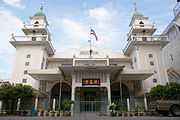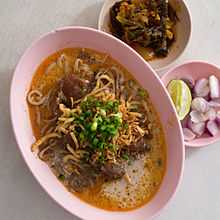Islam in Thailand

Islam is a minority faith in Thailand, with recent statistics suggesting a population of around 4 million, or almost 6% of the population.[1][2] Most Thai Muslims belong to the Sunni branch, although Thailand has a very diverse and developing population which includes immigrants from around the world.[3][4]
Demographics and geography
Popular opinion seems to hold that a vast majority of the country's Muslims are found in the Thailand's three Southernmost provinces of Yala, Pattani and Narathiwat, where they make up majority of the population.[5] However, the Thai Ministry of Foreign Affairs' research indicates that only 18% of Thai Muslims live in those three provinces. The rest are scattered throughout Thailand, with the largest concentrations being in Bangkok and throughout the larger Southern region. The population in Satun Province, which borders Malaysia as well, is also predominantly Muslim.
According to the National Statistics Office, in 2005, Muslims in Southern Thailand made up 30.4% of general population above the age 15, while less than 3% in other parts of the country.[6]
History
In Siam (modern Thailand) Indian Muslims from the Coromandel Coast served as eunuchs in the Thai palace and court.[7][8]
Ethnicity and identity

Thailand's Muslim population is diverse, with ethnic groups having migrated from as far as China, Pakistan, Cambodia, Bangladesh, Malaysia, and Indonesia, as well as comprising indigenous Thais, while about two-third of Muslims in Thailand are ethnically Malay.[9]
Indigenous Thai
Many Thai Muslims are ethnically and linguistically Thai, who are either hereditary Muslims, Muslims by intermarriage, or recent converts to the faith. Ethnic Thai Muslims live mainly in the Central and Southern provinces - varying from entire Muslim communities to mixed settlements.[10] Former Commander-in-Chief of the Royal Thai Army General Sonthi Boonyaratglin is an example of an indigenous Thai Muslim. Sonthi is of remote Persian ancestry. His ancestor, Sheikh Ahmad Qomi,[11][12] was an Iranian expatriate trader who lived in the Ayutthaya Kingdom for 26 years. Many Thais, including those of the Bunnag and Ahmadchula families trace their ancestry back to him.
Malay Muslims
In the three Southernmost border provinces, the vast majority of the local Muslim population is predominantly Malay in origin. These people, known colloquially as Yawi, speak a dialect of Malay that is not mutually understood by Thai speakers.[13] This adds to the culturally unique identity of Thai Malay Muslims.
The high number of Malay origin inhabitants in the Southern region is due the historical nature of the area, which was once known as the Pattani Kingdom, an Islamic Malay kingdom established in the nineteenth century, but later annexed to Siam (the older name of Thailand).[14] Similarly, there is an ethnic Thai minority in Northern Malaysia.
Chinese Muslims


In the far North, as well as in select Central and Southern urban areas, there are pockets of Thai Muslims of Chinese Hui origin.[15] Most Chinese Muslims belong to a group of people called Chin Ho or Haw in the Thai Language, although most of the Chin Ho are not Muslim. Some historians believed that the name Chin Ho can be explained to be a combination of "Chin" (China) and "Ho" (Hui). The Chin Ho people, thus, can be seen as traders and emigres who carried with them Hui Muslim traditions from China. One of the most famous Chinese mosque is Baan Haw Mosque, located in Chiang Mai Province.
Muslim groups
ethnic groups, such as the Rohingya are refugees and economic migrants who are scattered throughout Thailand's refugee camps, rural fishing villages, as well as in many small towns and cities close to the Myanmar border.
Northern Thailand, as well as being home to many Chinese Muslims, also is home to many Burmese, and mixed Chinese-Burmese or Pakistani-Burmese peoples.
Other Asian Muslim groups
- See also Pakistanis in Thailand
Other represented groups include Cham Muslims, originally from Cambodia who can be found between the mutual border and Bangkok as well as the deep south.
South Asians, including Indians, Bangladeshi, and Pakistanis can be found throughout Thailand working in professions ranging from wealthy business owners to lowly paid labourers.
Other groups include Indonesian Muslims, especially Bugis, Javanese and Minangkabau.
According to a 1685 account of a Persian diplomat as well as notes of the French traveler Guy Tachard, there was a substantial Shi'a Persian community in Siam at the time, with the ritual ta'zieh performances subsidized by the Siamese king.[16]
Distinctiveness of Thai Islam
Except in the small circle of theologically trained believers, the Islamic faith in Thailand, like Buddhism, has become integrated with many beliefs and practices not integral to Islam, like in other Southeast Asian countries like Indonesia and Malaysia.
In the South, it can be difficult to draw a line between animistic practices indigenous to Malay culture that were used to drive off evil spirits and local Islamic ceremonies because each contained aspects of the other.
Places of worship
According to National Statistic Office of Thailand in 2007, the country has 3,494 mosques, with the largest number (636) in Pattani province.[17] According to the Religious Affairs Department (RAD), 99% of the mosques are associated with the Sunni branch of Islam with the remaining 1% Shi'a.
Governance and education

Chularatchamontri (จุฬาราชมนตรี) is the title of Shaykh al-Islām in Thailand. The title was first used in the Ayutthaya Kingdom when King Songtham (1611–1628) appointed Sheikh Ahmad to the office. Pursuant to the current Islamic Organ Administration Act, BE 2540 (1997), Chularatchamontri is appointed by the King upon advice of the Prime Minister. He has the authority to administer all Islamic affairs in the Nation and to provide advice on Islamic affairs to government agencies. Chularatchamontri vacates his office upon death, resignation and removal by the King upon advice of the Prime Minister.
There is also a Central Islamic Council of Thailand (คณะกรรมการกลางอิสลามแห่งประเทศไทย) or CICOT (กอท.), consisting of at least five Councillors appointed by the King from amongst Muslims. The CICOT advises the Minister of Education and the Minister of Interior on Islamic matters. Its presiding officer is Chularatchamontri. Provincial Islamic Councils (คณะกรรมการอิสลามประจำจังหวัด) exist in the provinces that had substantial Muslim minorities. There are other links between the government and the Muslim community, including government financial assistance to Islamic education institutions, assistance with construction of some of the larger mosques, and the funding of pilgrimages by Thai Muslims to Mecca, both Bangkok and Hat Yai being primary gateway cities.
Thailand also maintains several hundred Islamic schools at the primary and secondary levels, as well as Islamic banks, including the Islamic Bank of Thailand, shops and other institutions. Much of the packaged food marketed is tested and labeled halal (unless it has pork), regardless of who eats it.
See also
- South Thailand insurgency
- Islam by country
- List of mosques in Thailand
- Pattani Kingdom
- Hidayatuddeneyah Mosque
References
- ↑ "The World Factbook". Cia.gov. Retrieved 2013-12-02.
- ↑ "Global Religious Landscape Table - Number of Population- Pew Forum on Religion & Public Life". Features.pewforum.org. 2012-12-18. Retrieved 2013-12-02.
- ↑
- ↑ "thai2arab.com". thai2arab.com. Retrieved 2013-12-02.
- ↑ "Muslim in Thailand". Retrieved 2.11.2012. Check date values in:
|accessdate=(help) - ↑ "สรุปผลการสํารวจการเข??ารวมก ?? จกรรมทางว ิ ัฒนธรรม พ.ศ. 2548". Service.nso.go.th. Retrieved 2013-12-02.
- ↑ Peletz (2009), p. 73 Gender Pluralism: Southeast Asia Since Early Modern Times, p. 73, at Google Books
- ↑ Peletz (2009), p. 73 Gender Pluralism: Southeast Asia Since Early Modern Times, p. 73, at Google Books
- ↑ "Thailand". Lcweb2.loc.gov. Retrieved 2013-12-02.
- ↑ Gilquin, Michel (2002). The Muslims of Thailand. IRASEC (Silkworm Books). ISBN 974-9575-85-7.
- ↑ "ŕ¸Šŕ¸ľŕ¸§ŕ¸´ŕ¸•ŕš ŕ¸Ľŕ¸°ŕ¸œŕ¸Ľŕ¸‡ŕ¸˛ŕ¸™ŕ¸šŕ¸´ŕšŠŕ¸ ŕ¸šŕ¸ąŕ¸‡ : ŕ¸‚ŕšˆŕ¸˛ŕ¸§ŕ¸ ŕ¸˛ŕ¸Łŕš€ŕ¸Ąŕ¸ˇŕ¸ŕ¸‡". Tnews.teenee.com. Retrieved 2013-12-02.
- ↑ "Siam Media News - ÊÂÒÁÁÕà´ÕÂ ¹ÔÇÊì". Siammedia.org. Retrieved 2013-12-02.
- ↑
- ↑
- ↑
- ↑
- ↑
 This article incorporates public domain material from websites or documents of the Library of Congress Country Studies.
This article incorporates public domain material from websites or documents of the Library of Congress Country Studies.
External links
| Wikimedia Commons has media related to Islam in Thailand. |
- Islamic Schools in Thailand
- The First Islamic Website in Thailand
- (Thai) Islam in Thailand
- "The Muslim Fishermen of Phang Nga" by Antonio Graceffo
- Global Security - Thailand
- islam.in.th
- Hidayatuddeneyah Mosque
- Papers on Islam in Thailand by Imtiyaz Yusuf
| ||||||||||||||
| ||||||||||||||||||||